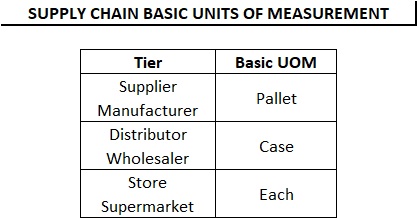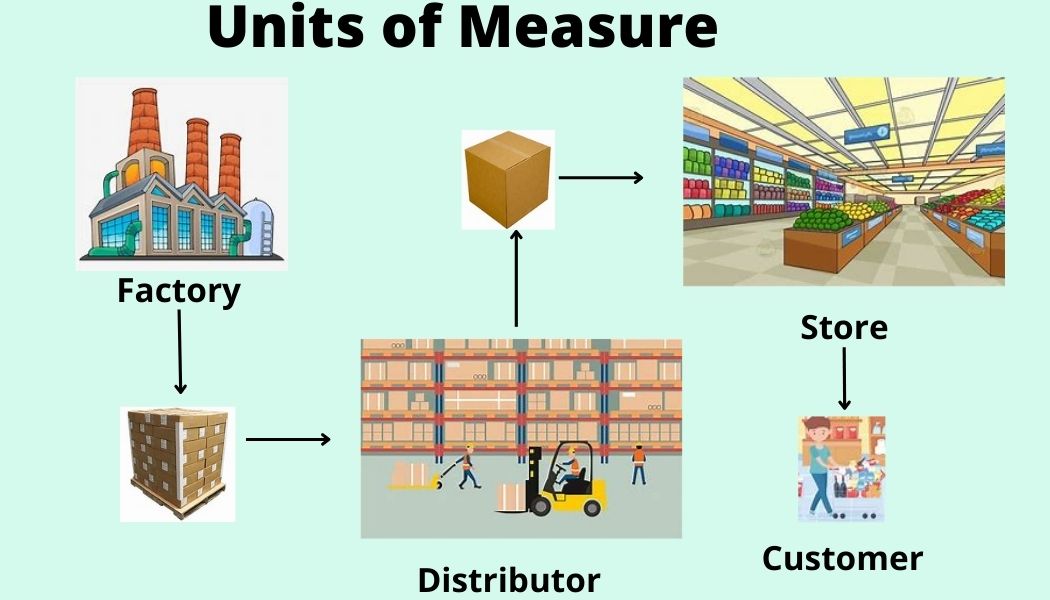In a distribution operation, it is normal for the quantity of products purchased from a supplier, stored in the warehouse, and sold to customers to have different units of measure. In this article, I will explain what is units of measure, how they work, and how to set them up within your accounting system or WMS..
Unit of measurement (UOM): Basic definitions
In a distribution and warehousing operation, a Unit Of Measurement (UOM) or unit of measure is the method by which you measure an item. UOMs are used to quantify inventory items and allow them to be tracked trough the supply chain process. It can be weight, mainly for raw material, or quantities.
The smallest unit of a product is called the “Basic Unit”. It is normally the minimum quantity of an item that you buy in a store. For example, you can buy 1 bottle of milk or 1 cartoon of eggs, or 1 box of screws. In the wholesale industry this basic unit is called “Each”. But a distributor cannot store the products in each; products are normally packed and stored in a bigger package through which they sell to the store or supermarket, typically called a “Case”. The “case” is nothing more than a box or bag with many “each” of the product, and it is the basic unit to sell to the stores. So, Distributor A sells to Store B 1 case of tuna cans with 10 units (each) per case. Store B receives the cases, opens them, and places the 10 cans of tuna on the shelf for the consumer to buy.
On the same token, the manufacturer does not produce or store the products in “each” or “cases”. They normally store and sell them to distributors, and sometimes directly to supermarkets, by the pallet with a certain number of cases per pallet. Therefore, the pallet is often the supplier’s or manufacturer’s base unit in the supply chain structure.
This is exactly how units of measurement work and how it works for the supplier, the distributor and the end consumer. The figure below illustrates the structure of the units of measurement along the chain.

Why are Units of Measure Important in Distribution?
Units of measurement are crucial in any business, but their importance is paramount when it comes to inventory management and distribution transactions. They serve as the universal language through which all stakeholders within the supply chain communicate and concur on the quantity of goods. Neglecting the proper handling of units of measure can result in costly errors.
To illustrate this, consider the scenario of Store “A” and Distributor “B.” Store “A” employs “each” as its fundamental unit of measure, while Distributor “B” defaults to cases. Store “A” places an order with Distributor “B” for 20 units of tuna cans, equivalent to 2 cases in Distributor “B’s” terminology. If Distributor “B” lacks a units of measurement system, it might misinterpret Store “A’s” order as a request for 20 cases instead of the intended 2 cases. This misunderstanding initiates a sequence of actions that results in unnecessary expenses and customer dissatisfaction.
An example of the criticality of units iof measurement mishandling dates back to 1999 when a hospital encountered an incident involving a patient who received 0.5 grams of phenobarbital, a sedative, instead of 0.5 grains. A grain, an old unit of measure, is approximately equal to 0.065 grams. Fortunately, the patient survived, but this incident underscored the need for precise unit measurements in healthcare and any sector.
Implementing Effective UOM Strategies:
To obtain the benefits of UOM in distribution and warehousing, consider the following strategies:
- Standardization: Establish clear UOM standards throughout your warehouse to minimize confusion and errors.
- Training: Ensure that warehouse staff understands how to use UOM effectively and accurately.
- Software Integration: Implement warehouse management software that supports UOM, automating processes and reducing manual data entry.
- Regular Audits: Conduct periodic audits to verify that UOM data in your system aligns with physical inventory.
- Flexibility: Be prepared to adjust UOM as needed to accommodate changes in products or customer requirements.
Promoting USA and UOM
Promoting USA can assist you in structuring the Units of Measure levels and configure into your Warehouse or ERP system. If you want to learn more, give us your information to schedule a meeting.
I will continue to post information related to trade channel management, general economy and market trends. If you are interested in this article or want to learn more about Promoting USA, please subscribe to stay updated on future articles.

